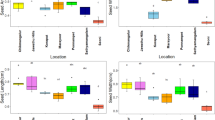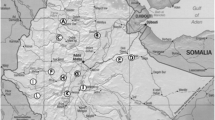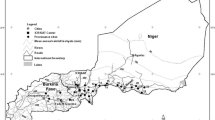Abstract
The genetic variation in seed weight, seed number per kg and seedling traits was compared among eight Acacia senegal provenances originating from the clay plain (east) and sand plains (west) of the gum belt in Sudan. The main objective of this study was to identify germplasm sources of A. senegal that have a good seed germination capacity and seedling traits suitable for reforestation in the clay-soil part of the dryland gum belt in the Blue Nile region in Sudan. A specific objective was to tentatively explore the adaptive strategy of A. senegal populations. Seventeen-week-old seedlings were planted in the field at spacing of 3 m × 3 m, giving 100 trees per plot and replication; within a randomized complete block design with four replications. The experimental site was in the clay plain region. Seed variables showed significant differences. Clay plain provenances showed considerable variation in seed weight and seed number. They had the smallest seed weight but the highest seed number, while the sand (western) provenances had the largest seed weight but lowest seed number. Seedling branch number, root length, root to shoot ratio and shoot dry weight differed significantly among the provenances 12 weeks after germination. Clay provenances had the highest branch number and shoot dry weight but the shortest roots and lowest root to shoot ratio. This was interpreted as showing better adaptation to the site in these local provenances in comparison to those originating from the western sandy soil regions. High positive correlations were observed between seedling variables, such as root nodule and branch numbers; this could be used for early selection. The variation was greater between provenance groups than within them, suggesting that especially selection among groups would yield genetic gain.







Similar content being viewed by others
References
Antunez I, Retamosa EC, Villar R (2001) Relative growth rate in phylogenetically related deciduous and evergreen woody species. Oecologia 128:172–180
Ballal ME, El Siddig EA, Elfadl MA, Luukkanen O (2005) Relationship between environmental factors, tapping dates, tapping intensity and gum arabic yield of an Acacia senegal plantation in western Sudan. J Arid Environ 63:379–389
Bernard A (1996) Provenance trial of Acacia auriculiformis A. Cuun. Ex Benth. The Sabah experience. In: Dieters MJ, Matheson AC, Nikles DG, Harwood CE, Walker SM (eds) Tree improvement for sustainable tropical forestry. Proceedings of QFRI-IUFRO Conference (pp 182–184). 27 October-1 November 1996, Caloundra, Queensland, Australia
Castro-Diez P, Puyravaud JP, Cornelissen JHC, Villar-Salvador P (1998) Stem anatomy and relative growth rate in seedlings of a wide range of woody plant species and types. Oecologia 116:57–66
Chapin FS III (1991) Integrated responses of plants to stress. A centralized system of physiological responses. BioScience 41:29–36
Cony MA, Trione SO (1998) Inter-and intraspecific variability in Prosopis flexuosa and P. chilensis: seed germination under salt and moisture stress. J Arid Environ 40:307–317
Cornelissen JHC, Castro-Diez P, Hunt R (1996) Seedling growth, allocation and leaf attributes in a wider range of woody plant species and types. J Ecol 84:755–765
Cornelissen JHC, Werger MJA, Castro-Diez P, Rheenen JWA, Van Rowland AP (1997) Foliar nutrients in relation to growth, allocation and leaf traits in seedlings of a wide range of woody plants species and types. Oecologia 111:460–469
Dangasuk OG, Seurei P, Gudu S (1997) Genetic variation in seed and seedling traits in 12 African provenances of Faidherbia albida (Del.) A. Chev. at Lodwar, Kenya. Agroforest Syst 37:133–141
EL Amin HM (1990) Trees and shrubs of the Sudan. ISBN, Ithaca Press England
El Houri AA (1986) Some aspect of dryland afforestation in the Sudan with special reference to Acacia tortilis (Forks.) Hayne, Acacia senegal Willd. and Prosopis chilensis (Molina) Stuntz. Forest Ecol Manag 16:209–221
Evans AS, Cabin RJ (1995) Can dormancy affect the evolution of post germination traits? The case of Lesquerella tendleri. Ecology 76:344–356
Fonseca CR, Overton JM, Collins B, Westoby M (2000) Shifts in trait-combinations along rainfall and phosphorus gradient. J Ecol 88:964–977
Gaafar AM, Salih AA, Luukkanen O, Elfadl MA, Kaarakka V (2006) Improving the traditional Acacia senegal agroforestry-crop system in Sudan: the effect of tree density on water use, gum production and crop yields. Agroforest Syst 66:1–11
Hamann A, Koshy MP, Namkoong G, Ying CC (2000) Genotype × environment interactions in Alnus rubra: developing seed zones and seed-transfer guidelines with spatial statistics and GIS. Forest Ecol Manag 136:107–119
Harrier LA, Whitty P, Sutherland JM, Sprent JI (2000) Pre-infection events in non-nodulating species of African Acacia. Afr J Ecol 38:8–15
Hoffmann WA, Poorter H (2002) Avoiding bias in calculations of relative growth rate. Ann Bot 80:37–42
Khurana E, Singh JS (2004a) Response of five tropical tree seedlings to elevated CO2 of seed size and successional status. New Forests 27:139–157
Khurana E, Singh JS (2004b) Germination and seedling growth of five tree species from tropical dry forest in relation to water stress: impact of seed size. J Trop Ecol 20:385–396
Kleinschmit J, Kownatzki D, Gregorius H-R (2004) Adaptational characteristics of autochthonous populations-consequences for provenance delineation. Forest Ecol Manag 197:213–224
Kozlowski TT, Kramer PJ, Pallardy SG (1991) The physiological ecology of woody plants. Academic press, San Diego, California
Li P, Beaulieu J, Daoust G, Plourde A (1997) Pattern of adaptive genetic variation in eastern white pine (Pinus strobus). Can J Forest Res 27:199–206
Lieberman D, Li M (1992) Seedling recruitment patterns in a tropical dry forest in Ghana. J Veg Sci 3:375–382
Mantovan NG (2002) Early growth differentiation among Prosopis flexuosa D.C. provenances from the Monte phytogeographic province, Argentina. New Forests 23:19–30
Midgley JJ, Bond WJ (2001) A synthesis of the demography of African acacias. J Trop Ecol 17:871–886
Milberg P, Lamont BB (1997) Seed/cotyledon size and nutrient content play a major role in early performance of species on nutrient-poor soil. New Phytol 137:665–672
Milberg P, Maria A, Fernandez P, Lamont BB (1998) Seedling growth response to added nutrients depends on seed size in three woody genera. J Ecol 86:624–632
Moles AT, Westoby M (2004) Seedling survival and seed size: a synthesis of the literature. J Ecol 92:372–383
Otegbeyer GO, Samarawira I (1992) Correlation of growth and form characteristics of Eucalyptus camaldulensis Dehnh. Provenances in northern Nigeria. Forest Ecol Manag 50:275–285
Palmberg C (1981) A vital fuelwood gene pool is in danger. Unasylva (FAO) 33:133
Poorter H, Remkes C (1990) Leaf area ratio and assimilation rate of 24 wild species differing in relative growth rate. Oecologia 83:553–559
Raddad EY, Luukkanen O (2006) Adaptive genetic variation in water-use efficiency and gum yield in Acacia senegal provenances grown on clay soil in the Blue Nile region, Sudan. Forest Ecol Manag 226:219–229, DOI 10.1016/j.foreco.2006.01.036
Raddad EY, Salih AA, Elfadl MA, Kaarakka V, Luukkanen O (2005) Symbiotic nitrogen fixation in eight Acacia senegal provenances in dryland clays of the Blue Nile Sudan estimated by the 15N natural abundance method. Plant and Soil 275:261–269
Raebild A, Graudal L, Ouedraogo LG (2003) Evaluation of provenance trial of Acacia senegal at Dori, Burkina Faso. Trail no. 8 in the arid zone series. Results and documentation No.3. DANIDA Forest Seed Centre, Humlebaek, Denmark
Ray GJ, Brown BJ (1995) Restoring Caribbean dry forests: evaluation of tree propagation techniques. Restor Ecol 3:86–94
Rehfeldt GE (1984) Microevolution of conifers in the northern Rocky Mountains: a review from common gardens. In: Proceedings of the Eighth North American Forest Biology Workshop, Logan, UT, pp 132–146
Rehfeldt GE (1991) A model of genetic variation for Pinus ponderosa in the Inland Northwest (U.S.A.): applications in gene resource management. Can J Forest Res 21:1491–1500
Rehfeldt GE (1995) Genetic variation, climate models and the ecological genetics of Latrix occidentalis. Forest Ecol Manag 78:21–37
Riemenschneider DE, McMahon BG (1993) Genetic variation among Lake States Balsam popular populations is associated with geographic origin. Forest Sci 39:130–136
Roughgarden J (ed) (1979) Theory of population genetics and evolutionary ecology: an introduction. MacMillan, New York
SAS (1997) JMP statistical package. SAS Institute, Inc, Cary, N.C, USA
Steel RGD, Torrie JH (1980) Principles and procedures of statistics, 2nd edn. McGraw-Hill, New York
Sun D, Dickson GR, Bragg AL (1995) Morphological variation between twelve provenances of Grevillia robusta planted in northeast Queensland. Aust Forest 58(2):129–134
Verzino G, Carranza C, Ledesma M, Joseau J, Di Rienzo J (2003) Adaptive genetic variation of Prosopis chilensis (Molina) Stuntz preliminary results from one test-site. Forest Ecol Manag 175:119–129
Walter MB, Kruger EL, Reich PB (1993) Relative growth rate in relation to physiological and morphological traits for northern hardwood tree seedlings: species, light environment and ontogenetic considerations. Oecologia 96:219–231
Westoby M, Flaster DS, Moles AT, Vesk PA, Wright IJ (2002) Plant ecological strategies: some leading dimensions of variation between species. Annu Rev Ecol Syst 33:125–159
Wright RA, Wein RW, Dancik BP (1992) Population differentiation in seedling root size between adjacent stands of jack pine. Forest Sci 38:777–785
Acknowledgements
The work reported here was carried out under a research project funded by the Academy of Finland (Grant 78373) “Integrated Forest Resources Management for Combating Desertification in Sudano-Sahelian Africa”. We thank M. A. Khateeb, the staff at the Forestry Research Damazin for invaluable assistance. The author is grateful to Prof. O. Luukkanen for his valuable comments on the manuscript.
Author information
Authors and Affiliations
Corresponding author
Rights and permissions
About this article
Cite this article
Raddad, E.A.Y. Ecophysiological and genetic variation in seedling traits and in first-year field performance of eight Acacia senegal provenances in the Blue Nile, Sudan. New Forests 34, 207–222 (2007). https://doi.org/10.1007/s11056-007-9049-4
Received:
Accepted:
Published:
Issue Date:
DOI: https://doi.org/10.1007/s11056-007-9049-4




